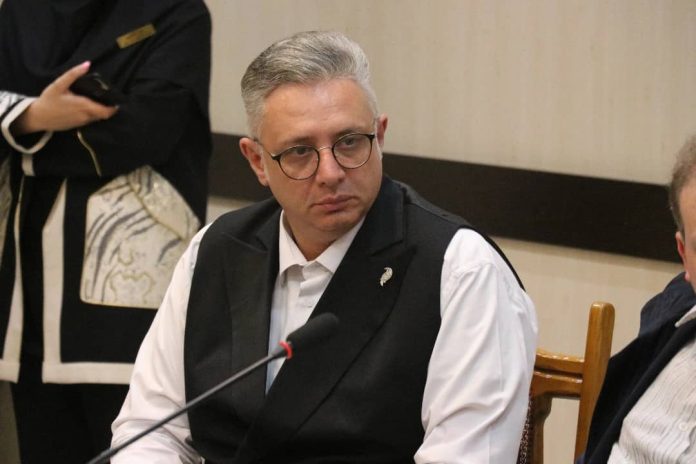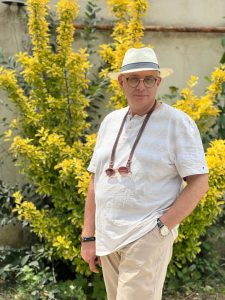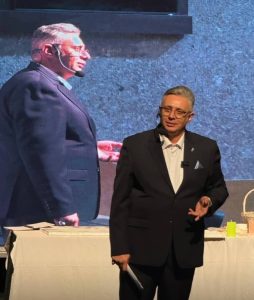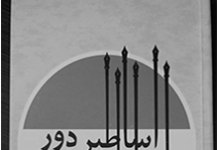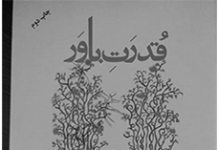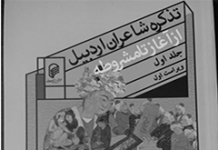Introduction
Vahid Ziaei (وحید ضیائی) is a distinctive figure in modern Persian literature, whose poetic and prose writings have attracted critical attention for their psychological depth and innovative use of language. Situated at the crossroads of Iran’s rich literary tradition and modern literary experimentation, Ziaei’s works reflect a nuanced understanding of the human psyche, social upheaval, and identity struggles characteristic of late 20th and early 21st-century Iran. This paper seeks to provide a comprehensive psychoanalytic interpretation of Ziaei’s oeuvre, grounded in contemporary psychoanalytic theory, and simultaneously introduce his artistic significance to an international, English-speaking audience unfamiliar with Persian literature.
This study draws on foundational psychoanalytic concepts articulated by Sigmund Freud, Jacques Lacan, and later theorists such as Julia Kristeva and Julia Kristeva’s exploration of language and the unconscious, to illuminate the undercurrents of desire, repression, trauma, and the fragmented self present in Ziaei’s writing. The goal is to not only decode the psychological layers in his work but also to contextualize his literary innovations within Iran’s socio-political landscape and global literary currents.
Vahid Ziaei’s Literary Position in Iran
Before delving into psychoanalytic analysis, it is essential to situate Ziaei in the context of contemporary Iranian literature. Iranian literature, with its centuries-old tradition of poetry and mysticism, has undergone significant transformations in the modern era. The 20th century witnessed shifts influenced by Western literary movements, political revolutions, and rapid modernization, resulting in a dynamic but complex literary scene.
Ziaei is part of a generation of poets and writers who endeavor to reconcile this heritage with contemporary realities. Unlike classical Persian poets such as Hafez and Rumi, whose works are steeped in mysticism and allegory, or the modernist movement led by figures like Nima Yooshij who introduced free verse and new themes, Ziaei’s writing is characterized by a synthesis of psychoanalytic insight and socio-political awareness.
His literary output is not only valued for its aesthetic qualities but also for its capacity to articulate the fragmented Iranian identity shaped by war, censorship, diaspora, and rapid cultural change. This duality—rootedness in tradition and engagement with modernity—is what makes Ziaei a key figure in the Iranian literary canon and a subject of growing interest in comparative literary studies.
Psychoanalytic Foundations for Analyzing Ziaei’s Work
To approach Vahid Ziaei’s literature from a psychoanalytic perspective, it is necessary to outline the key concepts that will guide the analysis. Classical Freudian theory introduces the unconscious as a repository of repressed desires and traumas that shape conscious behavior and creative expression (Freud, The Interpretation of Dreams). Later psychoanalytic thinkers, such as Jacques Lacan, expanded on Freud by emphasizing language’s role in structuring the unconscious and the fragmented nature of the self (Écrits, Lacan).
Ziaei’s poetry and prose can be read through these lenses: the use of metaphor, fragmentation, and symbolic language as expressions of unconscious drives, conflicts, and the tensions between the individual and society. Furthermore, Julia Kristeva’s work on abjection and the semiotic chora (Kristeva, Powers of Horror) offers a framework for understanding the visceral and sometimes disturbing imagery in Ziaei’s writing, which reflects cultural trauma and identity crisis.
By integrating these psychoanalytic theories, this paper will explore three primary themes in Ziaei’s work: identity fragmentation, repression and desire, and social trauma.
Identity Fragmentation and the Psyche
One of the most striking features of Ziaei’s literature is its engagement with the fractured self. Iranian society’s complex history, marked by revolution, war, exile, and cultural censorship, often manifests as a split or fragmented identity in his work. Psychoanalysis identifies such fragmentation as a symptom of the divided subject, caught between conflicting desires and prohibitions (Lacan, 1977).
Ziaei’s texts frequently depict characters or poetic voices struggling to reconcile disparate parts of their identities—between tradition and modernity, personal desire and societal expectations, individual autonomy and collective memory. This mirrors Lacan’s notion of the “split subject,” where the ego is not unified but divided by unconscious drives and linguistic structures.
Through this lens, Ziaei’s work can be seen as a literary enactment of the psychological struggle for coherence amid the pressures of historical trauma and cultural displacement.
Repression and Desire in Ziaei’s Writing
In psychoanalytic theory, repression is the mechanism by which unacceptable desires and traumatic memories are pushed into the unconscious, only to resurface symbolically in artistic expression (Freud, Beyond the Pleasure Principle). Ziaei’s literary work embodies this dynamic, frequently engaging with themes of forbidden desire, loss, and unspoken anguish.
His poetry often employs imagery that suggests the tension between the conscious suppression of personal and collective pain and its inevitable eruption through metaphor and symbolic narrative. For example, the recurring motifs of darkness, silence, and brokenness in his works can be interpreted as manifestations of repressed emotions that seek acknowledgment.
Moreover, Ziaei’s treatment of desire is not limited to personal longing but extends to a cultural and political dimension. The desire for freedom, identity, and self-expression under oppressive circumstances is a central undercurrent in his writings. This aligns with Lacanian psychoanalysis, which frames desire as a fundamental force shaped by language and social structures but always marked by lack and incompleteness (Lacan, The Four Fundamental Concepts of Psychoanalysis).
Through this prism, Ziaei’s literature offers insight into the psychic conflicts experienced by individuals living in socio-political constraint, revealing how repression and desire interact to shape both personal and collective narratives.
Social Trauma and Collective Memory
Another key psychoanalytic dimension of Ziaei’s oeuvre is its engagement with social trauma and collective memory. Drawing on the work of theorists such as Cathy Caruth (Unclaimed Experience) and Aleida Assmann (Cultural Memory and Western Civilization), trauma is understood as an experience that resists full integration into consciousness and continuously haunts the psyche.
Ziaei’s writings reflect this persistent hauntology, often dealing with the aftermath of war, exile, and cultural suppression in Iran. His literary representations of fragmented histories and disjointed memories echo the psychoanalytic notion of trauma as an event that remains “unspeakable” and disrupts temporal continuity.
The author’s use of ambiguous narrative structures and symbolic imagery can be seen as an attempt to articulate what is otherwise inexpressible—giving voice to the repressed cultural wounds. This corresponds with Freud’s observation of trauma’s effect on the psyche as a repetition compulsion, where the individual is caught in a cycle of reliving past wounds (Freud, Beyond the Pleasure Principle).
Therefore, Ziaei’s literature functions not only as personal catharsis but also as a medium for collective remembrance and healing.
The Symbolism of Identity and the Unconscious in Ziaei’s Work
In psychoanalytic terms, identity formation is deeply connected with the dynamics of the unconscious. The fragmented self and the tension between personal and social identities often surface in literature as symbols and metaphors, which Ziaei masterfully employs.
His poetry and prose frequently explore the conflicts arising from dual or multiple identities, a common experience for many Iranians navigating cultural, political, and diasporic realities. This resonates with Erik Erikson’s concept of identity crisis and Jacques Lacan’s theory of the “split subject” — where the self is divided between the “I” as perceived and the “I” as desired or repressed (Erikson, Identity: Youth and Crisis; Lacan, Écrits).
Ziaei’s use of mirrors, masks, and shadows as recurring images reflects this psychoanalytic motif, symbolizing the fragmented and fluid nature of identity. These images reveal the tensions between appearance and reality, conscious self-presentation and unconscious drives.
Through this symbolic language, Ziaei invites the reader to engage in a psychoanalytic reading that uncovers the deep structures of the self in conflict, thus enriching the understanding of identity beyond surface narratives.
Language, Silence, and the Unspoken
Psychoanalysis places a significant emphasis on language as the medium through which unconscious content is expressed, concealed, or distorted. Ziaei’s writing style, often marked by elliptical language, silences, and carefully placed pauses, exemplifies this psychoanalytic principle.
According to Julia Kristeva (Powers of Horror) and Lacan, language is inherently incomplete, and the “unsayable” or the “silenced” forms a crucial part of the psychic landscape. Ziaei’s deliberate use of ellipsis and fragmented sentences can be interpreted as an artistic strategy to evoke the ineffable, allowing the reader to sense what remains hidden beneath the surface.
This stylistic choice mirrors the psychoanalytic process itself — where the analyst listens not only to what is said but also to what is left unsaid, and where meaning is constructed through gaps and silences.
Ziaei’s linguistic approach thus invites an active participation from the reader, compelling them to enter into the interstices of meaning and engage with the unconscious layers embedded in his text.
The Role of Trauma and Memory in Ziaei’s Literary World
One of the pivotal psychoanalytic themes in Ziaei’s work is trauma and its reverberations in memory and identity. Drawing upon Freud’s foundational work on trauma (Beyond the Pleasure Principle) and contemporary developments in trauma theory (e.g., Cathy Caruth’s Unclaimed Experience), Ziaei’s writing often grapples with the ways in which painful, repressed memories shape the present psyche.
His characters and poetic voices frequently inhabit spaces marked by loss, exile, and historical violence — reflecting the collective trauma experienced by Iranian society over decades of political upheaval, war, and social change.
Ziaei’s narratives expose how trauma resists full integration into consciousness, producing symptoms of repetition, fragmentation, and haunting memories. The psychoanalytic concept of “working-through” (Freud) is mirrored in his texts’ oscillation between confrontation and avoidance of painful past events.
This engagement with trauma offers not only a personal catharsis but also a cultural testimony, making Ziaei a critical voice in contemporary Iranian literature who channels the unconscious wounds of his nation into artistic expression.
The Intersection of Eroticism and the Sublime
Another dimension of psychoanalytic interest in Ziaei’s work is the treatment of eroticism, desire, and sublimation. Influenced by Freudian theories on libido and sublimation (Three Essays on the Theory of Sexuality), Ziaei explores how erotic impulses are channeled into creative acts and spiritual transcendence.
His poetry often navigates the liminal space between sensuality and the sublime, employing metaphors of light, fire, and the divine. This reflects the psychoanalytic view that art can serve as a sublimated expression of unconscious desires, transforming primal urges into higher forms of beauty and meaning.
This dynamic is also resonant with the work of Julia Kristeva and Roland Barthes on the semiotics of desire and the language of the body, further deepening the psychoanalytic reading of Ziaei’s erotically charged imagery.
Symbolism and the Unconscious in Ziaei’s Poetic Language
Ziaei’s poetic language is deeply symbolic, serving as a conduit to access the unconscious mind. Drawing from Carl Jung’s theory of archetypes and symbols, as well as Lacanian psychoanalysis regarding language and the unconscious (“the unconscious is structured like a language”), his imagery often functions on multiple levels simultaneously.
Symbols such as the night, the mirror, water, and the labyrinth recur throughout his works, each bearing complex layers of meaning related to identity, self-reflection, transformation, and existential uncertainty. These symbols operate as gateways to the unconscious, allowing the reader to experience emotional and psychic depths beyond rational understanding.
Moreover, Ziaei’s deliberate use of ambiguity and fragmentation in syntax echoes the psychoanalytic notion that the unconscious resists straightforward expression and reveals itself through indirect, encoded means such as dreams and free association.
Social Critique through Psychoanalytic Lens
Beyond individual psyche, Ziaei’s work incorporates social critique embedded in psychoanalytic theory, especially in relation to collective repression and ideology (Althusser, Marcuse).
His poetry and prose critique authoritarian structures and cultural taboos that enforce psychic repression, social conformity, and alienation. By exposing the unconscious mechanisms of power and control—such as denial, projection, and splitting—Ziaei’s literature challenges the societal status quo and advocates for psychological and political liberation.
This intersection of psychoanalysis and politics situates him within a broader tradition of socially conscious Iranian writers who use art as a form of resistance and collective healing.
Psychological Themes and Existential Depth in Ziaei’s Work
One of the central psychological themes in Ziaei’s oeuvre is the confrontation with existential anxiety. Drawing on the psychoanalytic perspectives of Freud and later existential psychoanalysts like Viktor Frankl, Ziaei’s poetry explores the human struggle with meaninglessness, death, and alienation.
His writings portray the psychic tension between desire and loss, hope and despair, often dramatizing the inner conflicts of the self in a fractured modern world. This reflects Freud’s notion of the “death drive” (Thanatos) and the tension between life instincts (Eros) and destructive impulses, which Ziaei transforms into vivid metaphors within his poetic language.
The tension is not only personal but collective—Ziaei’s works echo the psychic wounds of post-revolutionary Iranian society, where political repression and cultural censorship complicate individuals’ search for identity and freedom. His poetry acts as a therapeutic space, allowing both personal and social trauma to surface and be symbolically worked through.
Ziaei’s Literary Position in Iranian Contemporary Literature
To understand Ziaei’s significance, one must situate him within the trajectory of modern Persian literature. Contemporary Iranian poetry has been marked by a dynamic tension between classical forms and modernist experimentation, and Ziaei skillfully negotiates both.
He is often associated with the postmodernist wave of Iranian poets who reject simplistic narratives and embrace complexity, ambiguity, and intertextuality. His psychoanalytic approach to themes such as identity fragmentation, the unconscious, and trauma distinguishes him from many contemporaries who focus more on overt political or social commentary.
Moreover, Ziaei’s synthesis of Western psychoanalytic theory with Persian poetic tradition is a crucial contribution, enriching the intellectual landscape of Iranian literature by opening new hermeneutic possibilities.
The Interplay of the Unconscious and Symbolism in Ziaei’s Poetry
Ziaei’s poetry is deeply imbued with symbolic imagery that resonates with the psychoanalytic concept of the unconscious. Drawing from Carl Jung’s theory of archetypes alongside Freudian symbolism, Ziaei crafts a poetic world where symbols act as bridges between conscious experience and unconscious content.
His frequent use of water, darkness, and labyrinth motifs reflects universal psychic symbols of the unconscious depths, mystery, and the search for meaning. This symbolism facilitates a dialogue between personal and collective unconscious, allowing readers to confront latent fears, desires, and suppressed memories.
The poet’s linguistic style—rich in metaphor, ambiguity, and layered meanings—mirrors the complex workings of the mind and the processes of repression and sublimation. This stylistic choice not only enhances the aesthetic quality of his work but also aligns with the psychoanalytic method of interpreting dreams and texts as manifestations of unconscious processes.
Trauma, Memory, and the Psyche: A Psychoanalytic Reading
A salient feature of Ziaei’s poetry is its engagement with trauma and memory, central concepts in both psychoanalysis and contemporary literary studies. His work frequently addresses personal and collective traumas, reflecting the historical and sociopolitical upheavals that have shaped modern Iran.
Through psychoanalytic lenses, these poetic texts can be seen as attempts to narrate and work through trauma, offering a cathartic function for both poet and reader. Drawing on Cathy Caruth’s trauma theory, Ziaei’s poetry articulates the ‘unclaimed experience’—events so overwhelming that they resist full conscious integration.
This resistance to narrative closure is reflected in the fragmented and non-linear structure of his poems, evoking the psychic reality of trauma survivors whose memories are often disjointed and elusive. By engaging with these themes, Ziaei contributes to the ongoing dialogue about healing, identity reconstruction, and the role of art in psychological recovery.
Conclusion: The Psychoanalytic Lens as a Gateway to Understanding Ziaei’s Work
In sum, applying psychoanalytic theory to the works of Vahid Ziaei offers profound insights into the psychological depth and complexity of his poetry. His exploration of unconscious desires, existential anxieties, trauma, and identity resonates with foundational psychoanalytic concepts, bridging individual experience with collective cultural realities.
Moreover, Ziaei’s literary position as a mediator between classical Persian traditions and modern psychoanalytic thought situates him as a pivotal figure in contemporary Iranian literature. His works invite both psychoanalytic interpretation and literary appreciation, serving as fertile ground for cross-cultural and interdisciplinary studies.
Through this psychoanalytic reading, non-Iranian audiences can better appreciate the rich psychological and cultural layers embedded in Ziaei’s poetry, promoting a deeper global understanding of contemporary Persian literary art.
Conclusion
The psychoanalytic exploration of Vahid Ziaei’s poetry reveals a rich and multi-layered engagement with the complexities of the human psyche. By delving into themes such as the unconscious, symbolism, trauma, and memory, Ziaei not only expresses personal and collective experiences but also taps into universal psychological dynamics that resonate across cultures.
His adept use of symbolic imagery, influenced by both classical Persian literary heritage and modern psychoanalytic thought, creates a unique poetic language that bridges tradition and contemporary insights. This blend positions him as an important figure in Iran’s literary scene—one who revitalizes Persian poetry by infusing it with profound psychological depth.
For English-speaking audiences unfamiliar with Iranian literature, this psychoanalytic perspective opens a window into the emotional and existential


